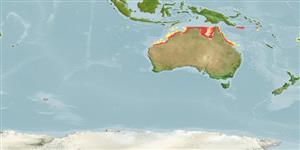>
Atheriniformes (Silversides) >
Atherinidae (Silversides) > Craterocephalinae
Etymology: Craterocephalus: Greek, krater, -eros = bowl, mixing vessel + Greek, kephale = head (Ref. 45335).
Environment: milieu / climate zone / depth range / distribution range
Écologie
marin; saumâtre. Tropical; 11°S - 21°S
Eastern Indian Ocean and Western Central Pacific: northern Australia, from Western Australia to Fraser Island, around the islands of the Gulf of Carpentaria, and northeast Queensland.
Taille / Poids / Âge
Maturity: Lm ? range ? - ? cm
Max length : 7.0 cm TL mâle / non sexé; (Ref. 9760)
Épines anales: 1. Labial ligament inserting adjacent to symphysis of dentary. Lateral process of premaxilla pungent. Gill rakers on first lower gill arch, 13-17. Body scales on large specimens usually crenulated, midlateral scales 33-37. Black spot often present at base of pectoral fin.
Mainly coastal and estuarine, often schooling with C. capreoli, Atherinomorus endrachtensis and A. ogilbyi. Diet includes crustaceans and diatoms. Breeds from December to March throughout the southern hemisphere. Appears to have a one year life span. May be food fish for larger commercially important fishes.
Life cycle and mating behavior
Maturité | Reproduction | Frai | Œufs | Fécondité | Larves
Ivantsoff, W. and L.E.L.M. Crowley, 1999. Atherinidae. Silversides (or hardyheads). p. 2113-2139. In K.E. Carpenter and V.H. Niem (eds.) FAO species identification guide for fishery purposes. The living marine resources of the Western Central Pacific. Volume 4. Bony fishes part 2 (Mugilidae to Carangidae). FAO, Rome. (Ref. 9760)
Statut dans la liste rouge de l'IUCN (Ref. 130435: Version 2024-1)
Menace pour l'homme
Harmless
Utilisations par l'homme
Pêcheries: sans intérêt
Outils
Articles particuliers
Télécharger en XML
Sources Internet
Estimates based on models
Preferred temperature (Ref.
123201): 26.3 - 28.7, mean 27.7 °C (based on 250 cells).
Phylogenetic diversity index (Ref.
82804): PD
50 = 0.5000 [Uniqueness, from 0.5 = low to 2.0 = high].
Bayesian length-weight: a=0.00389 (0.00180 - 0.00842), b=3.12 (2.94 - 3.30), in cm total length, based on all LWR estimates for this body shape (Ref.
93245).
Niveau trophique (Ref.
69278): 2.8 ±0.36 se; based on food items.
Résilience (Ref.
120179): Haut, temps minimum de doublement de population inférieur à 15 mois (Preliminary K or Fecundity.).
Fishing Vulnerability (Ref.
59153): Low vulnerability (10 of 100).
